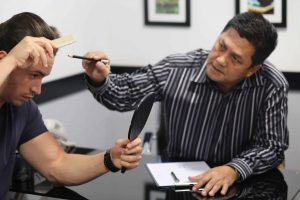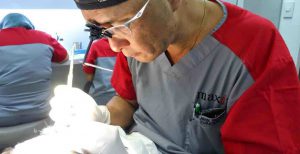WHAT IS HAIR REPLACEMENT?
What is Hair Replacement?
Hair loss may have a negative impact on a person’s appearance and self-esteem. Surgical hair replacement aims to fill in or recreate thinning hairlines and other regions of the scalp where hair loss is visible. Hair loss can affect both men and women. The primary cause of a receding hairline in men is heredity (male pattern baldness). Hormonal modifications, such as menopause among other factors can cause hair thinning and hair loss in women.
The positive is that the hair growth industry has come a long way and now offers a variety of hair loss therapies and treatments. Hair replacement and hair transplants are the most common. Traditionally, hair replacement constituted hair pieces, hair systems, toupees, and wigs.
Hair replacement surgery, on the other hand, is a form of surgery that transplants hair you already have at the back and sides of the head to fill in an area where your hair is thinning. Also, it is a procedure if you have lost a significant amount of hair. There has been a substantial rise in demand for hair replacement surgery. Doctors have been performing this procedure for more than 60 years. However, the methods they use have changed quite a bit in recent years. To find out more about hair replacement surgery, this page is right for you.
What You Should Know About Hair Replacement Surgery?
A hair replacement procedure is a life-changing surgical treatment that helps people regain their confidence. It corrects obvious defects in the thickness and style of your hair, making it a long-term investment in your self-esteem. While hair replacement surgery may not be able to benefit those who are completely bald, there are a variety of hair replacement techniques available that can also be combined with non-surgical solutions.
Non-surgical Hair Replacement is for you if you want to regain a complete head of hair without undergoing surgery. These natural-looking hair additions, hair systems, hair pieces and extensions are nearly undetectable to touch or sight and are non-invasive, simple, and fuss-free. Hair replacement systems are designed for men who have advanced hair loss or baldness. There are hair extensions that do not need surgery and are virtually undetectable to the naked eye or touch. The Hair Replacement System, a hair weave appropriate for those who only need partial hair additions, is an alternative to hair transplant surgery.
MAXIM plants to launch an array of non-surgical hair replacement solutions and options that are unrivaled when it comes to hair systems! At MAXIM Hair Restoration, we plan to create hairpieces, wigs and hair systems for people suffering from hair loss and medical disorders using a completely innovative procedure. Per hairpiece, the device is handcrafted and personalized according to the customer’s hair tastes, style, texture, and desires.

What is a Hair System?
Synthetic hair or a wig is hand-woven into a certain base cloth, such as lace, to create a hair system. The base is then applied to the person’s head using the desired form of binding (tape or adhesive). After that, sliced and mixed to seal it in.
Advanced hair replacement allows people with mild to advanced hair loss to drastically alter their look. Anyone, regardless of age, hair color, or degree of hair loss, may wear a hair system. To begin, the hair replacement specialist/stylist will check your hair to see if more hair can be added to give it a fuller look. When using new hairpieces with the right adhesive, there are very few drawbacks. You can also wash, sleep, work, swim, trim, style, and dye your hair as though it were your real hair. To put it another way, you should practically live your life like you would if you didn’t have it. How long the hair system would last is impossible to determine. Many aspects influence this, like the foundation material and how you maintain the hairpieces.
In addition, it may take six to eight weeks to tailor-make the hair pieces after an initial consultation. The front hairline will be nearly undetectable, and you will be able to shave, swim, and participate in sports as normal. You’ll get 15 weeks of wear on average before you need a bolster injection to keep the system in tip-top shape.

Types of Hair Replacement Surgery and how it works.
Today, hair replacement surgery is performed right in the doctor’s office. The surgeon cleans your scalp and injects a local anesthetic to numb the area of your head. Along with your doctor, you will have chosen one of two types of hair transplant, either follicular unit transplantation (FUT) or follicular unit extraction (FUE.)
The entire process takes anywhere from four to eight hours, depending on the number of grafts. Following the surgery, your scalp may be sensitive. You may need to take pain medication and either an antibiotic or an anti-inflammatory for a few days, which your doctor will prescribe. Also, you’ll need to wear a bandage over your scalp for at least a day or two.
1. Follicular unit transplantation (FUT or strip method)
For the FUT method, the surgeon will remove a six- to 10-inch strip of skin from the back of your head. After that, the surgeon sets the strip aside and sews the scalp closed, allowing the area to be immediately hidden by the hair surrounding it. Next, the strip is dissected into 1,000 to 3,000 small grafts. Each with one or just a few hair follicles, depending on your hair type, color, quality, and the size of the transplant area. The surgeon sutures the donor area to seal the wound from where the hair is extracted.
2. Follicular Unit Extraction (FUE)
First, the hair is shaved from the back of the head. Our surgeons or clinicians harvest and extract hair follicles one at a time. The affected area heals with only small dots, which your existing hair covers. From this point forward, both the FUT and FUE procedures are the same. After the grafts are prepared, the surgeon cleans and numbs the area in which the hair will be transplanted. They use a scalpel or needle for each recipient site. FUE does not result in linear scars.
Hair replacement surgery takes around a day. So, you shouldn’t have to wait overnight. If you’re treating a wide area, you can need two or three sessions spaced a few years apart. Your MAXIM surgeon and staff will instruct you on how to take care of your grafts and scalp. You will have a spray to use to aid hair growth and recovery.
What to expect after Hair Replacement?
Following hair replacement surgery, most people are likely to return to work within a few days. For the first two weeks after your surgery, you must be very cautious with your transplanted hair on the scalp. If not cared for, the grafts could get damaged. To stop scarring, it’s best to keep the workouts to a minimum for the first month. Follow all post-op instructions meticulously.
A few weeks following the hair restoration treatment, the transplanted hair will start to fall out. However, they will begin to regrow after four months. On average, most patients experience 60% of new hair growth after six to nine months. Improved density is apparent after a year. Nevertheless, you may need another procedure at a later date if you continue losing hair or if you decide you want thicker hair.
For a few days after hair replacement surgery, it’s not abnormal to have a strong, achy, and swollen scalp. There will be temporary scabbing where the hair is transplanted. Also, there will be a single scar or a series of very small scars in the donor area that generally fade over time.
How much does it cost?
Hair replacement surgery can be expensive. When seeking a hair replacement other considerations to remember include the cost of transport, the drugs needed following the transplant, and the recovery period. However, the average cost of a hair replacement varies greatly depending on the quantity of hair, but it typically ranges from $6,000 to $20,000. There are no insurance plans to protect it. However, 0% financing is available at MAXIM Hair Restoration. Also, talk with a professional and competent surgeon at MAXIM Hair Restoration who performs the procedure. It’s a good idea to talk to the specialist about the benefits, risks, potential complications, and recovery times.
If you decide to go the non-surgical route, the price of your hair system can vary depending on where you buy it, whether it’s ready-to-wear, and whether the coverage is partial or absolute. A limited coverage hair system can cost $800 to $1,200, while full coverage options can cost up to $2,500 or even higher. Premium systems are much higher. Monthly maintenance can be in the $200 range.
Contact Us:
We recognize that hair loss is a stressful experience, and it’s normal to have thoughts and questions along the way. We want you to know that we are still here to listen and assist you in whatever manner we can. Also, we take the time to listen to your needs, consider your objectives, and do a thorough health review. Our ability to devise customized strategies to create the healthy and natural look you crave is what distinguishes our hair loss solutions in MAXIM Hair Restoration.
A full head of hair helps a person feel happier, healthier, and more confident. Every day, people with thinning hair trust plastic and hair transplant surgeons and clinicians at MAXIM Hair Restoration to artfully create an attractive hairline for them. MAXIM has convenient locations in New York City, Long Island, Dallas, Houston, and Fort Worth in Texas, Northern Virginia (in the Washington, DC, and Maryland areas), and opening soon in Sarasota and Boca Raton, Florida, Chicago, Austin (Texas), Detroit (Michigan), Atlanta (Georgia) and other markets. Our international locations include Manila and Cebu, Philippines, Istanbul in Turkey, Poland, and Dubai.

